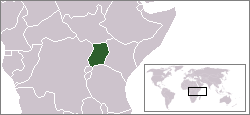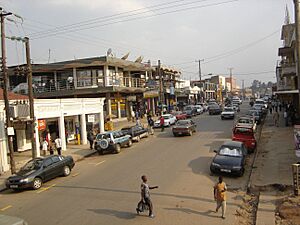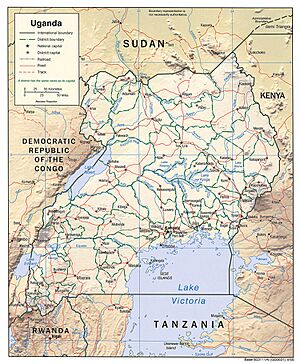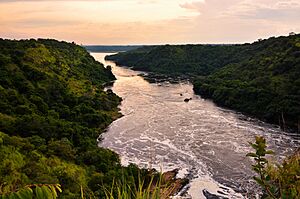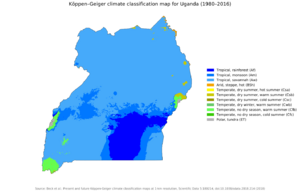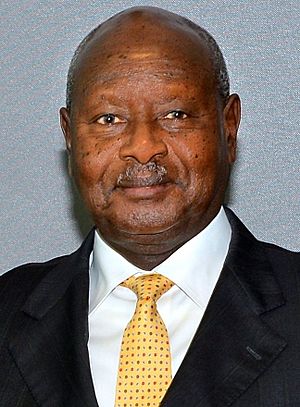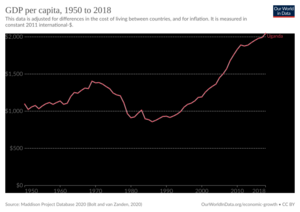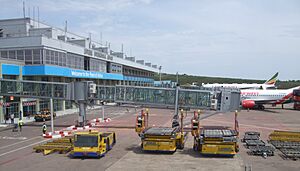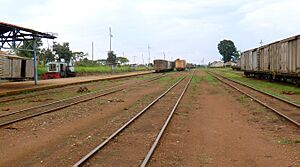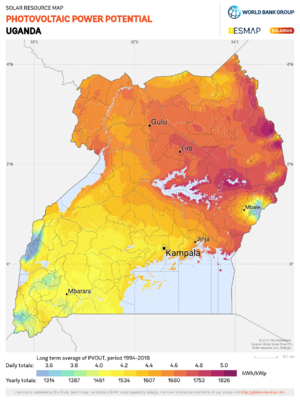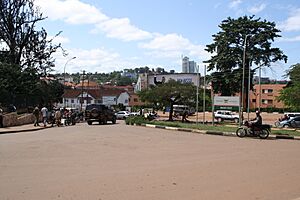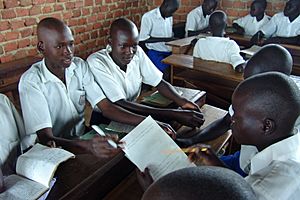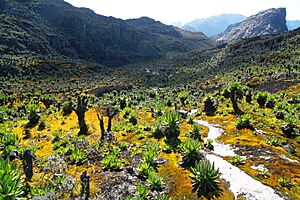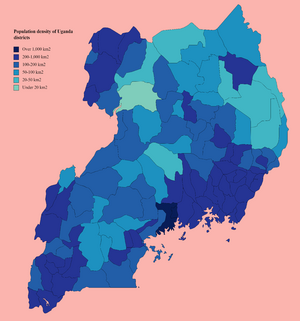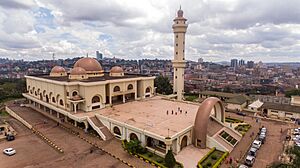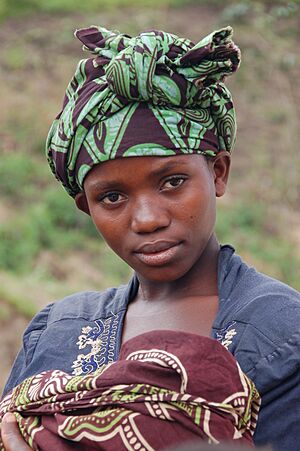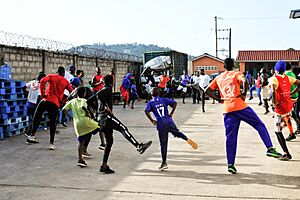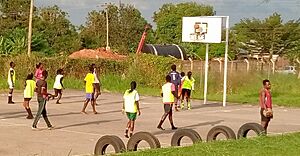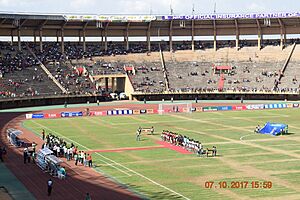Uganda facts for kids
Quick facts for kids
Republic of Uganda
Jamhuri ya Uganda (Swahili)
Official Name in Local Languages
|
|||||||
|---|---|---|---|---|---|---|---|
|
|
|||||||
|
Motto: "For God and My Country"
"Kwa Mungu na nchi yangu" |
|||||||
|
Anthem: "Oh Uganda, Land of Beauty"
|
|||||||
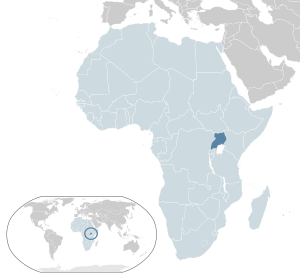 |
|||||||
| Capital and largest city
|
Kampala | ||||||
| Official languages |
|
||||||
| Ethnic groups
(2014)
|
|
||||||
| Religion
(2014 census)
|
|
||||||
| Demonym(s) | Ugandan | ||||||
| Government | Unitary presidential republic under a dominant-party authoritarian state | ||||||
| Yoweri Museveni | |||||||
| Jessica Alupo | |||||||
| Robinah Nabbanja | |||||||
| Legislature | Parliament | ||||||
| Independence
from the United Kingdom
|
|||||||
|
• Dominion
|
9 October 1962 | ||||||
|
• Admitted to the United Nations
|
25 October 1962 | ||||||
|
• Republic declared
|
9 October 1963 | ||||||
|
• Current constitution
|
8 October 1995 | ||||||
| Area | |||||||
|
• Total
|
241,038 km2 (93,065 sq mi) (79th) | ||||||
|
• Water (%)
|
15.39 | ||||||
| Population | |||||||
|
• 2024 estimate
|
49,283,041 (34th) | ||||||
|
• Density
|
157.1/km2 (406.9/sq mi) (75th) | ||||||
| GDP (PPP) | 2024 estimate | ||||||
|
• Total
|
|||||||
|
• Per capita
|
|||||||
| GDP (nominal) | 2023 estimate | ||||||
|
• Total
|
|||||||
|
• Per capita
|
|||||||
| Gini (2016) | ▲ 42.0 medium |
||||||
| HDI (2022) | medium · 159th |
||||||
| Currency | Ugandan shilling (UGX) | ||||||
| Time zone | UTC+3 (EAT) | ||||||
| Driving side | left | ||||||
| Calling code | +256a | ||||||
| ISO 3166 code | UG | ||||||
| Internet TLD | .ug | ||||||

Uganda is a country in eastern Africa. It is a landlocked nation, meaning it has no coastlines. Its capital and largest city is Kampala.
The money used in Uganda is the Ugandan Shilling. The country has two official languages: English and Swahili. Most people in Uganda follow Christianity. The current President of Uganda is Yoweri Museveni. Uganda is located in the eastern part of Africa. The country has a population of about 32 million people. Its total area is around 236,040 square kilometers.
Uganda is known for producing coffee and copper. About 68% of people aged 15 and older in Uganda can read and write. This is called the literacy rate.
Contents
History of Uganda
People have lived in Uganda for at least 50,000 years. Early people cleared forests to grow crops. They likely spoke Central Sudanic languages.
In 1894, Uganda became a 'protectorate' of the British Empire. This meant Britain controlled it. Uganda gained its independence from the United Kingdom in 1962. Sir Edward Muteesa Walugembe became the first President of Uganda.
Later, Idi Amin took power in 1971. He ruled for eight years until 1979. After several other leaders, Yoweri Museveni became president in 1986. He has led Uganda ever since.
Geography of Uganda
Uganda is in southeast Africa. It has a very varied landscape. You can find volcanic hills, mountains, and many lakes. The country is about 900 meters above sea level on average. Mountains are found on both the eastern and western borders. The Ruwenzori Mountains have Uganda's highest peak, Mount Alexandra, which is 5,094 meters tall.
Lakes and Rivers
A large part of southern Uganda is shaped by Lake Victoria. This is one of the world's biggest lakes and has many islands. Important cities like the capital, Kampala, are located near this lake. Lake Kyoga is in the center of Uganda. It is surrounded by large marshy areas.
Even though Uganda is landlocked, it has many big lakes. Besides Lake Victoria and Lake Kyoga, there are Lake Albert, Lake Edward, and Lake George. Most of Uganda is part of the Nile River basin. The Victoria Nile flows from Lake Victoria into Lake Kyoga. Then it goes into Lake Albert and continues north into South Sudan.
Wildlife and Nature
Uganda has 60 protected areas. These include ten national parks. Two of these, Bwindi Impenetrable National Park and Rwenzori Mountains National Park, are World Heritage Sites.
The country is home to many different animals. You can find mountain gorillas in Bwindi Impenetrable National Park. Hippos live in Murchison Falls National Park. You can also see golden monkeys in Mgahinga Gorilla National Park. The jackfruit tree is common throughout the country.
Government and Politics
The President of Uganda is the head of both the country and the government. The president chooses a vice-president and a prime minister to help with governing.
The country's law-making body is the National Assembly. It has 449 members. These members include representatives from different areas. There are also representatives for women, the army, youth, workers, and people with disabilities.
Administrative Divisions
As of 2022, Uganda is split into four regions and 136 districts. Rural areas are further divided into smaller sections like sub-counties and villages. Cities and towns have their own councils.
The Uganda Local Governments Association helps these local governments work together. Uganda also has five traditional kingdoms. These are Toro, Busoga, Bunyoro, Buganda, and Rwenzururu. They have some cultural independence.
Economy and Infrastructure
The Bank of Uganda is the country's central bank. It manages money policies and prints the Ugandan shilling.
Uganda's economy has been growing steadily. In 2015–16, the economy grew by 4.6%. The country has large amounts of crude oil and natural gas that have not yet been fully used. In the 1950s, many farmers joined co-operatives to help their businesses. Since 1986, the government has worked to improve the economy.
In 2012, the World Bank still listed Uganda as a "Heavily Indebted Poor Country." This means it had a lot of debt. Economic growth has not always reduced poverty for everyone.
Uganda depends on Kenya for access to the Mombasa port. But efforts are being made to create a new route. This new route would go through ports on Lake Victoria and then by railway to Tanga in Tanzania. Uganda is also a member of the East African Community.
Many Ugandans live abroad, especially in the United States and the United Kingdom. They send money back home, which helps Uganda's economy a lot. Uganda is also an economic center for nearby countries like the Democratic Republic of the Congo.
Transportation in Uganda
Uganda has 36 airports. Only four of them offer regular passenger flights. Entebbe International Airport is the main international airport. It is about 25 miles southwest of Kampala. A second international airport is being built in Hoima.
Road Network
Roads are the most important way to travel in Uganda. About 95% of all goods and people are moved by road. Uganda's road network is about 129,469 kilometers long. Only about 4% of these roads are paved. National roads make up 17% of the network but carry over 80% of all traffic.
Railroad Network
The rail network in Uganda is about 1,260 kilometers long. The longest lines connect Kampala to Tororo, Kampala to Kasese, and Tororo to Pakwach.
Communication and Technology
Uganda has many ways for people to communicate. These include phones, radio, TV, internet, mail, and newspapers. The use of phones and the internet has grown very quickly.
As of 2018, there were over 24 million phone users in Uganda. More than 95% of internet connections are made using mobile phones.
Energy Resources
Uganda has many energy resources spread across the country. These include hydropower, biomass, solar, and fossil fuels.
In the 1980s, most energy came from charcoal and wood. However, large amounts of oil have been found in the Lake Albert area. Uganda and Tanzania signed a deal in 2016 to build a 1,445 km oil pipeline. This pipeline will connect Uganda's oil region to the Indian Ocean port in Tanzania.
Uganda has a good environment for energy investments. It is one of the few African countries with open energy markets. This means private companies can invest in power generation and distribution.
Water Supply and Sanitation
Uganda has made good progress in providing water and sanitation in cities since the mid-1990s. More people have access to clean water. However, in 2010, 38% of the population still did not have access to an improved water source.
The government has made water and sanitation a key part of its plan to fight poverty. They have worked with international donors and other groups to improve these services.
Education in Uganda
Uganda's education system has changed a lot since the late 1990s. Children spend seven years in primary school and six years in secondary school. After that, they can go to post-secondary school for three to five years.
In 1997, primary school became free for all children. This had a huge impact. In 1986, only two million children were in primary school. By 1999, this number grew to six million.
In 2007, Uganda became the first country in sub-Saharan Africa to offer free secondary education. This led to a nearly 25% increase in secondary school enrollment between 2007 and 2012.
In 2002, Uganda's literacy rate was 66.8%. This means about two-thirds of adults could read and write. Public spending on education was 5.2% of the country's GDP between 2002 and 2005.
As of 2020, Uganda has 46 private universities that are officially recognized. These include Makerere University and Kampala International University.
Tourism in Uganda
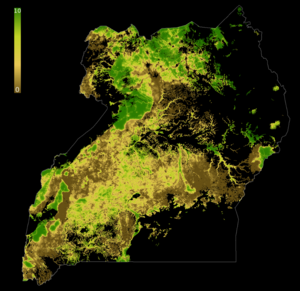
Tourism in Uganda focuses on its beautiful landscapes and wildlife. It helps create jobs and brings money into the country. The Uganda Tourism Board provides information for visitors.
The main attractions are photo safaris in the National parks and game Reserves. You can see mountain gorillas in Bwindi Impenetrable National Park. Uganda also has old cultural kingdoms and many cultural sites. It is a great place for birdwatching, with over 1073 recorded bird species. Uganda's landscapes range from the snow-capped Rwenzori Mountains to the Great Rift Valley.
Science and Technology
Uganda has a plan from 2009 to improve science, technology, and innovation. The goal is to use scientific knowledge to help Uganda develop. Uganda Vision 2040, launched in 2013, aims to make Uganda a modern and rich country in 30 years. This plan focuses on strengthening businesses, improving education, and modernizing infrastructure. It also looks at areas like oil, gas, tourism, and information technology.
Uganda was ranked 121st in the Global Innovation Index in 2024. The country has also made prototype cars called Kiira. The government has invested in this project.
Demographics of Uganda
Uganda's population grew from 9.5 million in 1969 to 34.9 million in 2014. The population increased by 10.6 million people in just 12 years. Uganda has the lowest median age in the world, at 15 years. This means half the population is younger than 15. Uganda also has one of the highest birth rates globally.
Before 1972, about 80,000 Indians in Uganda lived in Uganda. Many were forced to leave by Idi Amin. However, many have returned since 1979. Most Ugandan Indians live in Kampala. There are also about 10,000 white Africans and 3,000 Arabs in the country.
As of August 2021, Uganda hosts over 1.4 million refugees. Most come from nearby countries like South Sudan and the Democratic Republic of the Congo.
Languages Spoken
Swahili became Uganda's second official national language in 2005. It is widely used in the African Great Lakes region. Before 2005, English was the only official language. Swahili is very important in northern Uganda and is used by the police and military.
Religions in Uganda
The Roman Catholic Church has the most followers in Uganda, at 39.3%. The Anglican Church of Uganda is next, with 32% of the population. The number of Evangelical and Pentecostal Christians has grown a lot.
Islam is the next most common religion, with Muslims making up 14% of the population. A small number of people follow traditional religions or other faiths.
Largest Cities and Towns
|
Largest urban centres in Uganda
Uganda Bureau of Statistics 2016, National Population and Housing Census 2014 – Main Report, p. 11 |
||
|---|---|---|
| Rank | Pop. | |
| 1 | Kampala | 1,507,114 |
| 2 | Nansana | 365,857 |
| 3 | Kira | 317,428 |
| 4 | Makindye Ssabagabo | 282,664 |
| 5 | Mbarara | 195,160 |
| 6 | Mukono | 162,744 |
| 7 | Gulu | 149,802 |
| 8 | Lugazi | 114,163 |
| 9 | Kasese | 103,293 |
| 10 | Masaka | 101,557 |
Culture of Uganda
Uganda has a very diverse culture because of its many communities. Many people of Asian origin, who were forced to leave during Idi Amin's rule, have returned to Uganda.
Media in Uganda
Uganda has many media outlets that share news, magazines, sports, and entertainment.
Popular Ugandan newspapers include:
- New Vision
- Daily Monitor
- Bukedde
- The Observer
- East African Business Week
- Red Pepper
The most popular television stations in Uganda include:
- Uganda Broadcasting Corporation (UBC)
- NTV
- NBS Television
- Sanyuka TV
- Baba TV
- Top TV
- Spark TV
The Uganda Communications Commission (UCC) controls and regulates all media in Uganda.
Sports in Uganda
Football is Uganda's national sport. The Uganda national football team, known as "The Cranes," has never played in the FIFA World Cup. Their best result in the African Cup of Nations was second place in 1978.
Uganda has won a total of two gold, three silver, and two bronze medals at the Olympics. Most of these were in boxing and athletics. At the Commonwealth Games, Uganda has won 13 gold medals and 49 medals in total, all in boxing and athletics.
The Uganda national boxing team is called "The Bombers." They have won several medals at the Olympics and World Championships.
In athletics, John Akii-Bua won Uganda's first Olympic gold medal in 1972. He set a world record in the 400m hurdles. Other notable athletes include Stephen Kiprotich, who won the marathon at the 2012 London Olympics, and Joshua Cheptegei, who has set world records in long-distance running.
In cricket, Uganda was part of the East African cricket team that played in the 1975 Cricket World Cup. The Uganda national cricket team also qualified for the 2024 ICC T20 World Cup.
The Uganda national basketball team, nicknamed "The Silverbacks," is becoming more successful. They first played in the 2015 FIBA Africa Championship.
Cinema in Uganda
The film industry in Uganda is quite new but growing fast. It faces challenges, like competition from other countries and Hollywood films. However, there is support from film festivals.
The first film made entirely by Ugandans was Feelings Struggle in 2005. This marked the start of modern Ugandan cinema. Filmmakers in Uganda use different approaches. Some make films quickly, like in Nollywood, and show them in small video halls. Others try to make more artistic films but struggle with funding.
The Uganda Communications Commission (UCC) is working on rules that will require Ugandan TV channels to show more Ugandan content. This could help the local film industry grow even more.
Related pages
Images for kids
-
The Crested crane is the national bird.
-
U.S. President George W. Bush met with President Yoweri Museveni in Entebbe, Uganda, July 11, 2003.
-
Downtown Kampala, the capital city.
-
Northern corridor road from Kampala to Gulu at Matugga Town in Wakiso District
See also
 In Spanish: Uganda para niños
In Spanish: Uganda para niños




